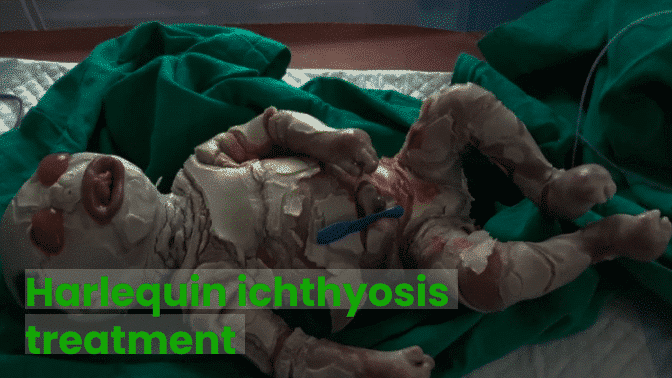Congenital ichthyosis or Harlequin infant syndrome are two more names for the uncommon skin disorder known as harlequin ichthyosis. It belongs to the category of illnesses known as ichthyosis, which is characterised by chronically dry, scaly skin all over the body.
A neonate with Harlequin ichthyosis has thick, diamond-shaped plates covering their skin that resemble fish scales. These plates might restrict airflow and restrict eating on the face. Harlequin ichthyosis necessitates prompt intensive care for babies.
While harlequin ichthyosis is a dangerous illness, medical progress has significantly improved the prognosis for infants born with it.
Unfortunately, there is currently no cure for harlequin ichthyosis, and the condition can be life-threatening if left untreated. However, there are several treatment options available that can help manage the symptoms and improve the quality of life for affected individuals.
The main goal of harlequin ichthyosis treatment is to prevent complications and manage symptoms. The treatment is usually provided by a team of specialists, including dermatologists, neonatologists, geneticists, and ophthalmologists.
One of the most important aspects of harlequin ichthyosis treatment is managing the baby’s skin. Infants with the condition are born with a thick layer of skin that can crack and fissure, leading to infection and dehydration.
To prevent this, the baby’s skin must be moisturized regularly with emollients such as petroleum jelly, and baths must be given using mild soap and warm water.
Antibiotics may also be prescribed to prevent or treat infections. It is important to keep the baby’s environment clean and sterile to reduce the risk of infection.
Causes of harlequin ichthyosis
Harlequin ichthyosis is a rare genetic skin disorder that is caused by mutations in the ABCA12 gene. This gene provides instructions for making a protein that is essential for the development of the skin’s outermost layer.
When this gene is mutated, it leads to the abnormal production of the protein, which results in the characteristic thick, scaly skin of harlequin ichthyosis.
The condition is inherited in an autosomal recessive pattern, meaning that an individual must inherit two copies of the mutated gene, one from each parent, to develop the condition. If an individual inherits only one copy of the mutated gene, they are a carrier of the condition and do not have symptoms.
It is important to note that harlequin ichthyosis is a rare condition, and it is estimated to affect only one in every 500,000 to one million births. The condition is more common in certain populations, such as those with a history of consanguinity (marriage between close relatives).
Other than genetic mutations, there are no known environmental or lifestyle factors that contribute to the development of harlequin ichthyosis. It is purely a genetic condition that is inherited from one’s parents.
Read Also: Exploring Non-medication Treatment Options for Chronic Pain Sufferers
Symptoms of harlequin ichthyosis
Harlequin ichthyosis is a rare genetic skin disorder that is present at birth. It is caused by mutations in the ABCA12 gene, which leads to the abnormal production of a protein responsible for maintaining the skin’s barrier function.
The condition is characterized by thick, scaly skin that forms diamond-shaped plates, resembling the pattern of a harlequin costume.
Some of the most common symptoms of harlequin ichthyosis include:
- Thick, scaly skin: Infants with harlequin ichthyosis are born with thick, scaly skin that forms diamond-shaped plates over their entire body. The scales can be very thick and hard, making movement and even breathing difficult.
- Red, swollen skin: The affected skin is often red and swollen, and it can crack and fissure, leading to painful skin infections.
- Difficulty breathing: The thick scales on the infant’s skin can make breathing difficult, which can be life-threatening in severe cases.
- Eye problems: Infants with harlequin ichthyosis are at increased risk of eye problems, such as dryness, corneal abrasions, and infections.
- Dehydration: The thick, scaly skin can make it difficult for the infant to retain moisture, leading to dehydration.
- Restricted movement: The thick, scaly skin can restrict the infant’s movement and flexibility, making it difficult to perform basic tasks such as feeding and bathing.
It is important to note that harlequin ichthyosis is a rare condition, and the symptoms can vary from person to person. Some infants may have milder symptoms, while others may have more severe symptoms that require immediate medical attention.
If you suspect that your infant may have harlequin ichthyosis, it is important to seek medical attention as soon as possible.
Prevention Measures
Harlequin ichthyosis is a rare genetic disorder that affects the skin. It is caused by mutations in the ABCA12 gene and is characterized by the thickening of the skin, severe dryness, and the formation of large, diamond-shaped plates that can crack and split open.
Unfortunately, there are no known preventive measures for Harlequin ichthyosis as it is a genetic condition that is inherited from parents who carry the mutated gene.
However, there are some measures that can be taken to manage the symptoms of Harlequin ichthyosis and improve the quality of life for those who are affected. These measures include:
- Regular moisturizing: Moisturizing the skin with emollients and other moisturizing agents can help to prevent cracking and splitting of the skin.
- Bathing in warm water: Bathing in warm water for short periods of time can help to soften the skin and make it easier to remove dead skin cells.
- Avoiding irritants: Avoiding harsh soaps, detergents, and other irritants can help to reduce skin irritation and inflammation.
- Using topical steroids: Topical steroids can be used to reduce inflammation and redness of the skin.
- Antibiotics and antifungal medications: These medications may be necessary to treat any infections that may develop as a result of cracked and broken skin.
It is also important for individuals with Harlequin ichthyosis to receive ongoing medical care from a dermatologist or other healthcare professional who is familiar with the condition. They can provide guidance on managing symptoms and addressing any complications that may arise.
Treatment of Harlequin ichthyosis
Harlequin ichthyosis is a rare genetic disorder that affects the skin and there is no cure for the condition. However, there are treatment options available that can help manage the symptoms and improve the quality of life for those who are affected.
Treatment options for Harlequin ichthyosis may include:
- Emollients and moisturizers: These are used to keep the skin soft and supple, and to prevent it from becoming dry and cracked.
- Topical steroids: These may be prescribed to reduce inflammation and redness of the skin.
- Antibiotics and antifungal medications: These medications may be necessary to treat any infections that may develop as a result of cracked and broken skin.
- Retinoids: These medications are derived from vitamin A and are used to help normalize skin cell growth and shedding. They may be used to treat severe cases of Harlequin ichthyosis.
- Nutritional support: In some cases, nutritional supplements may be recommended to help support overall health and well-being.
- Supportive care: This may include respiratory support, temperature regulation, and other measures to manage the symptoms and complications of the condition.
It is important for individuals with Harlequin ichthyosis to receive ongoing medical care from a dermatologist or other healthcare professional who is familiar with the condition. They can provide guidance on managing symptoms and addressing any complications that may arise.
In some cases, genetic counselling may also be recommended to help individuals and their families understand the inheritance patterns of the condition and the risks of passing it on to future generations.
Conclusion
while there is no cure for harlequin ichthyosis, the condition can be managed through a combination of skincare, eye care, nutrition, and medication. With proper treatment, affected individuals can live longer, healthier lives.
It is essential for individuals with harlequin ichthyosis to receive comprehensive care from a team of specialists to optimize outcomes and prevent complications.







